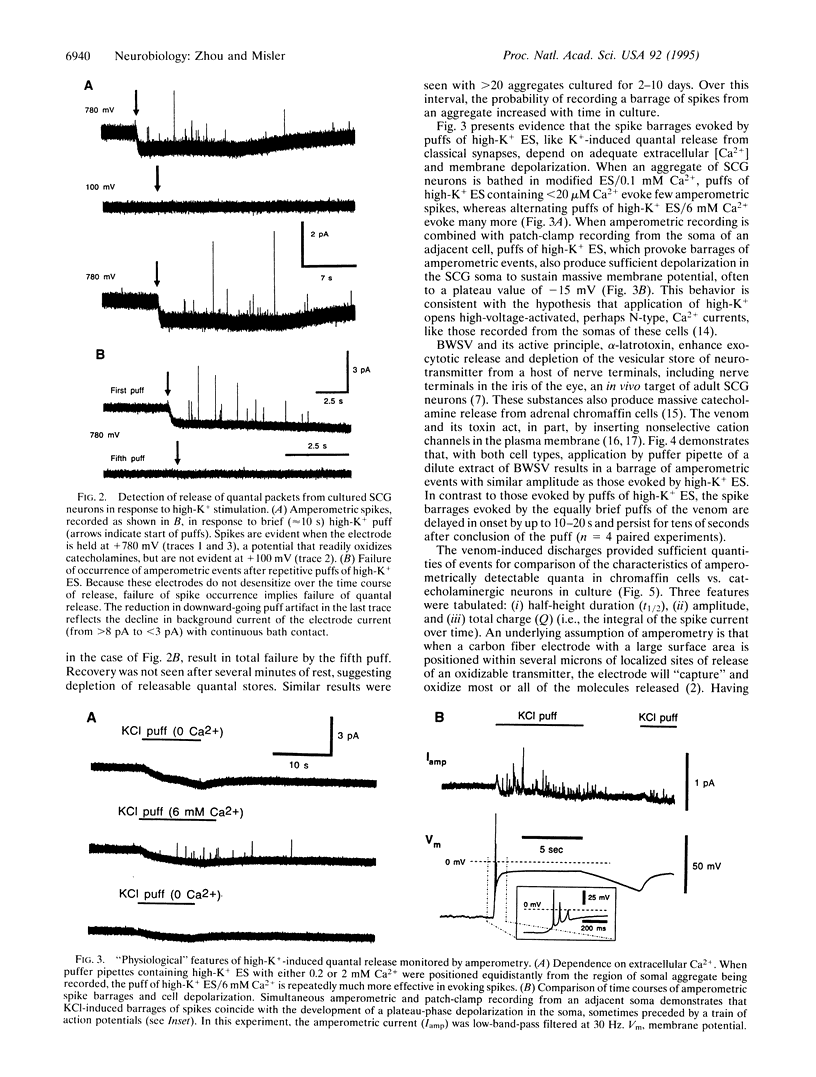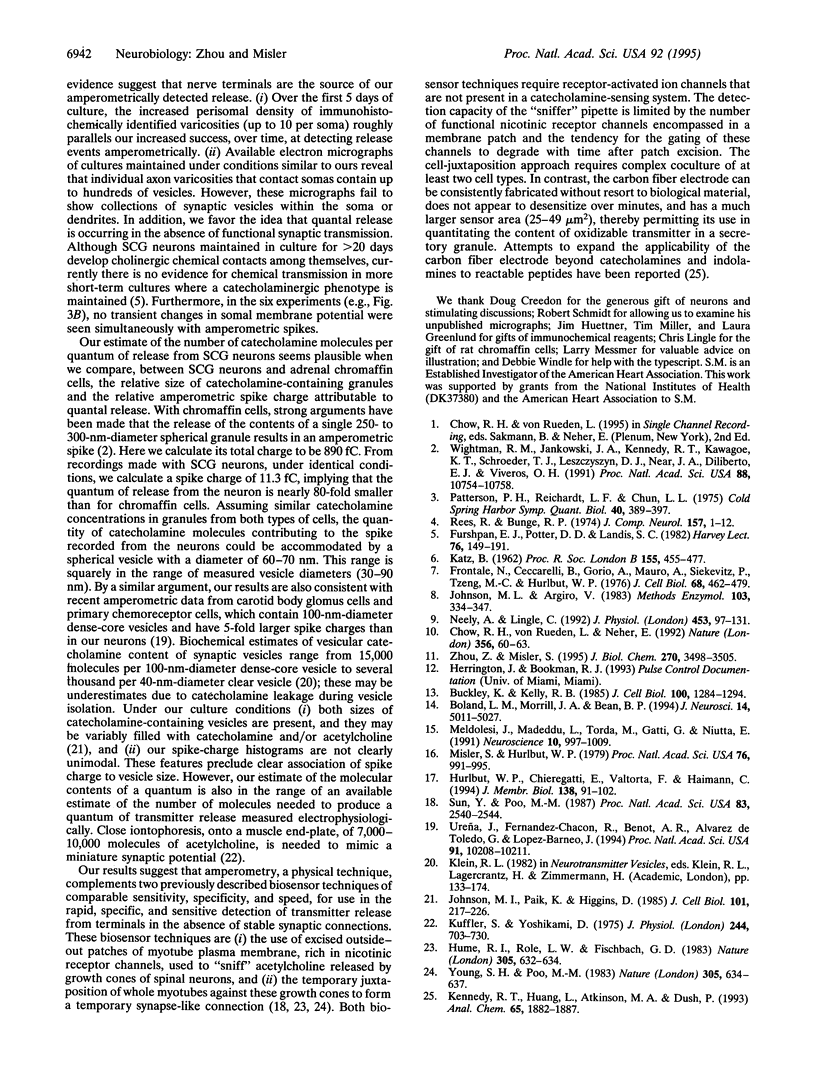Abstract
Amperometry has been used for real-time electrochemical detection of the quantal release of catecholamines and indolamines from secretory granules in chromaffin and mast cells. Using improved-sensitivity carbon fiber electrodes, we now report the detection of quantal catecholamine release at the surface of somas of neonatal superior cervical ganglion neurons that are studded with axon varicosities containing synaptic vesicles. Local application of a bath solution containing high K+ or black widow spider venom, each of which greatly enhances spontaneous quantal release of transmitter at synapses, evoked barrages of small-amplitude (2-20 pA), short-duration (0.5-2 ms) amperometric quantal "spikes". The median spike charge was calculated as 11.3 fC. This figure corresponds to 3.5 x 10(4) catecholamine molecules per quantum of release, or approximately 1% that evoked by the discharge of the contents of a chromaffin granule.
Full text
PDF




Images in this article
Selected References
These references are in PubMed. This may not be the complete list of references from this article.
- Boland L. M., Morrill J. A., Bean B. P. omega-Conotoxin block of N-type calcium channels in frog and rat sympathetic neurons. J Neurosci. 1994 Aug;14(8):5011–5027. doi: 10.1523/JNEUROSCI.14-08-05011.1994. [DOI] [PMC free article] [PubMed] [Google Scholar]
- Buckley K., Kelly R. B. Identification of a transmembrane glycoprotein specific for secretory vesicles of neural and endocrine cells. J Cell Biol. 1985 Apr;100(4):1284–1294. doi: 10.1083/jcb.100.4.1284. [DOI] [PMC free article] [PubMed] [Google Scholar]
- Chow R. H., von Rüden L., Neher E. Delay in vesicle fusion revealed by electrochemical monitoring of single secretory events in adrenal chromaffin cells. Nature. 1992 Mar 5;356(6364):60–63. doi: 10.1038/356060a0. [DOI] [PubMed] [Google Scholar]
- Frontali N., Ceccarelli B., Gorio A., Mauro A., Siekevitz P., Tzeng M. C., Hurlbut W. P. Purification from black widow spider venom of a protein factor causing the depletion of synaptic vesicles at neuromuscular junctions. J Cell Biol. 1976 Mar;68(3):462–479. doi: 10.1083/jcb.68.3.462. [DOI] [PMC free article] [PubMed] [Google Scholar]
- Furshpan E. J., Potter D. D., Landis S. C. On the transmitter repertoire of sympathetic neurons in culture. Harvey Lect. 1980;76:149–191. [PubMed] [Google Scholar]
- Hume R. I., Role L. W., Fischbach G. D. Acetylcholine release from growth cones detected with patches of acetylcholine receptor-rich membranes. Nature. 1983 Oct 13;305(5935):632–634. doi: 10.1038/305632a0. [DOI] [PubMed] [Google Scholar]
- Hurlbut W. P., Chieregatti E., Valtorta F., Haimann C. Alpha-latrotoxin channels in neuroblastoma cells. J Membr Biol. 1994 Feb;138(1):91–102. doi: 10.1007/BF00211072. [DOI] [PubMed] [Google Scholar]
- Johnson M. I., Argiro V. Techniques in the tissue culture of rat sympathetic neurons. Methods Enzymol. 1983;103:334–347. doi: 10.1016/s0076-6879(83)03022-0. [DOI] [PubMed] [Google Scholar]
- Johnson M. I., Paik K., Higgins D. Rapid changes in synaptic vesicle cytochemistry after depolarization of cultured cholinergic sympathetic neurons. J Cell Biol. 1985 Jul;101(1):217–226. doi: 10.1083/jcb.101.1.217. [DOI] [PMC free article] [PubMed] [Google Scholar]
- Kennedy R. T., Huang L., Atkinson M. A., Dush P. Amperometric monitoring of chemical secretions from individual pancreatic beta-cells. Anal Chem. 1993 Jul 15;65(14):1882–1887. doi: 10.1021/ac00062a012. [DOI] [PubMed] [Google Scholar]
- Kuffler S. W., Yoshikami D. The distribution of acetylcholine sensitivity at the post-synaptic membrane of vertebrate skeletal twitch muscles: iontophoretic mapping in the micron range. J Physiol. 1975 Jan;244(3):703–730. doi: 10.1113/jphysiol.1975.sp010821. [DOI] [PMC free article] [PubMed] [Google Scholar]
- Meldolesi J., Madeddu L., Torda M., Gatti G., Niutta E. The effect of alpha-latrotoxin on the neurosecretory PC12 cell line: studies on toxin binding and stimulation of transmitter release. Neuroscience. 1983 Nov;10(3):997–1009. doi: 10.1016/0306-4522(83)90238-5. [DOI] [PubMed] [Google Scholar]
- Misler S., Hurlbut W. P. Action of black widow spider venom on quantized release of acetylcholine at the frog neuromuscular junction: dependence upon external Mg2+. Proc Natl Acad Sci U S A. 1979 Feb;76(2):991–995. doi: 10.1073/pnas.76.2.991. [DOI] [PMC free article] [PubMed] [Google Scholar]
- Neely A., Lingle C. J. Two components of calcium-activated potassium current in rat adrenal chromaffin cells. J Physiol. 1992;453:97–131. doi: 10.1113/jphysiol.1992.sp019220. [DOI] [PMC free article] [PubMed] [Google Scholar]
- Patterson P. H., Reichardt L. F., Chun L. L. Biochemical studies on the development of primary sympathetic neurons in cell culture. Cold Spring Harb Symp Quant Biol. 1976;40:389–397. doi: 10.1101/sqb.1976.040.01.037. [DOI] [PubMed] [Google Scholar]
- Rees R., Bunge R. P. Morphological and cytochemical studies of synapses formed in culture between isolated rat superior cervical ganglion neurons. J Comp Neurol. 1974 Sep 1;157(1):1–11. doi: 10.1002/cne.901570102. [DOI] [PubMed] [Google Scholar]
- Sun Y. A., Poo M. M. Evoked release of acetylcholine from the growing embryonic neuron. Proc Natl Acad Sci U S A. 1987 Apr;84(8):2540–2544. doi: 10.1073/pnas.84.8.2540. [DOI] [PMC free article] [PubMed] [Google Scholar]
- Ureña J., Fernández-Chacón R., Benot A. R., Alvarez de Toledo G. A., López-Barneo J. Hypoxia induces voltage-dependent Ca2+ entry and quantal dopamine secretion in carotid body glomus cells. Proc Natl Acad Sci U S A. 1994 Oct 11;91(21):10208–10211. doi: 10.1073/pnas.91.21.10208. [DOI] [PMC free article] [PubMed] [Google Scholar]
- Wightman R. M., Jankowski J. A., Kennedy R. T., Kawagoe K. T., Schroeder T. J., Leszczyszyn D. J., Near J. A., Diliberto E. J., Jr, Viveros O. H. Temporally resolved catecholamine spikes correspond to single vesicle release from individual chromaffin cells. Proc Natl Acad Sci U S A. 1991 Dec 1;88(23):10754–10758. doi: 10.1073/pnas.88.23.10754. [DOI] [PMC free article] [PubMed] [Google Scholar]
- Young S. H., Poo M. M. Spontaneous release of transmitter from growth cones of embryonic neurones. Nature. 1983 Oct 13;305(5935):634–637. doi: 10.1038/305634a0. [DOI] [PubMed] [Google Scholar]
- Zhou Z., Misler S. Action potential-induced quantal secretion of catecholamines from rat adrenal chromaffin cells. J Biol Chem. 1995 Feb 24;270(8):3498–3505. [PubMed] [Google Scholar]




